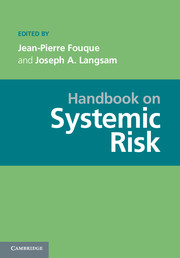Book contents
- Frontmatter
- Contents
- Contributors
- Introduction
- PART I DATA: THE PREREQUISITE FOR MANAGING SYSTEMIC RISK
- PART II STATISTICS AND SYSTEMIC RISK
- PART III MEASURING AND REGULATING SYSTEMIC RISK
- PART IV NETWORKS
- PART V SYSTEMIC RISK ANDMATHEMATICAL FINANCE
- PART VI COUNTERPARTY RISK AND SYSTEMIC RISK
- PART VII ALGORITHMIC TRADING
- PART VIII BEHAVIORAL FINANCE: THE PSYCHOLOGICAL DIMENSION OF SYSTEMIC RISK
- PART IX REGULATION
- 26 The New Financial Stability Framework in Europe
- 27 Sector-Level Financial Networks and Macroprudential Risk Analysis in the Euro Area
- 28 Systemic Risk EarlyWarning System: A Micro-Macro Prudential Synthesis
- PART X COMPUTATIONAL ISSUES AND REQUIREMENTS
- PART XI ACCOUNTING ISSUES
- References
28 - Systemic Risk EarlyWarning System: A Micro-Macro Prudential Synthesis
from PART IX - REGULATION
Published online by Cambridge University Press: 05 June 2013
- Frontmatter
- Contents
- Contributors
- Introduction
- PART I DATA: THE PREREQUISITE FOR MANAGING SYSTEMIC RISK
- PART II STATISTICS AND SYSTEMIC RISK
- PART III MEASURING AND REGULATING SYSTEMIC RISK
- PART IV NETWORKS
- PART V SYSTEMIC RISK ANDMATHEMATICAL FINANCE
- PART VI COUNTERPARTY RISK AND SYSTEMIC RISK
- PART VII ALGORITHMIC TRADING
- PART VIII BEHAVIORAL FINANCE: THE PSYCHOLOGICAL DIMENSION OF SYSTEMIC RISK
- PART IX REGULATION
- 26 The New Financial Stability Framework in Europe
- 27 Sector-Level Financial Networks and Macroprudential Risk Analysis in the Euro Area
- 28 Systemic Risk EarlyWarning System: A Micro-Macro Prudential Synthesis
- PART X COMPUTATIONAL ISSUES AND REQUIREMENTS
- PART XI ACCOUNTING ISSUES
- References
Summary
Abstract From the financial supervisor's point of view, an early warning system involves an ex ante approach to regulation, targeted to predict and prevent crises. An efficient EWS allows timely ex ante policy action and can reduce the need for ex post regulation. This chapter builds on existing microprudential and macroprudential early warning systems (EWSs) to propose a hybrid class of models for systemic risk, incorporating the structural characteristics of the financial system and a feedback amplification mechanism. The models explain financial stress using data from the five largest bank holding companies, regressing institutional imbalances using an optimal lag method. The z-scores of institutional data are justified as explanatory imbalances. The models utilize both public and proprietary supervisory data. The Systemic Assessment of Financial Environment (SAFE) EWS monitors microprudential information from systemically important institutions to anticipate the buildup of macroeconomic stresses in the financial markets at large. To the supervisor, SAFE offers a toolkit of possible institutional actions that can be used to diffuse the buildup of systemic stress in the financial markets. A hazard inherent in all ex ante models is that the model's uncertainty may lead to wrong policy choices. To mitigate this risk, SAFE develops two modeling perspectives: a set of medium-term (six-quarter) forecasting specifications that gives policymakers enough time to take ex ante policy action, and a set of short-term (two-quarter) forecasting specifications for verification and adjustment of supervisory actions. Individual financial institutions may utilize the public version of SAFE EWS to enhance systemic risk stress testing and scenario analysis.
- Type
- Chapter
- Information
- Handbook on Systemic Risk , pp. 791 - 846Publisher: Cambridge University PressPrint publication year: 2013
References
- 2
- Cited by



